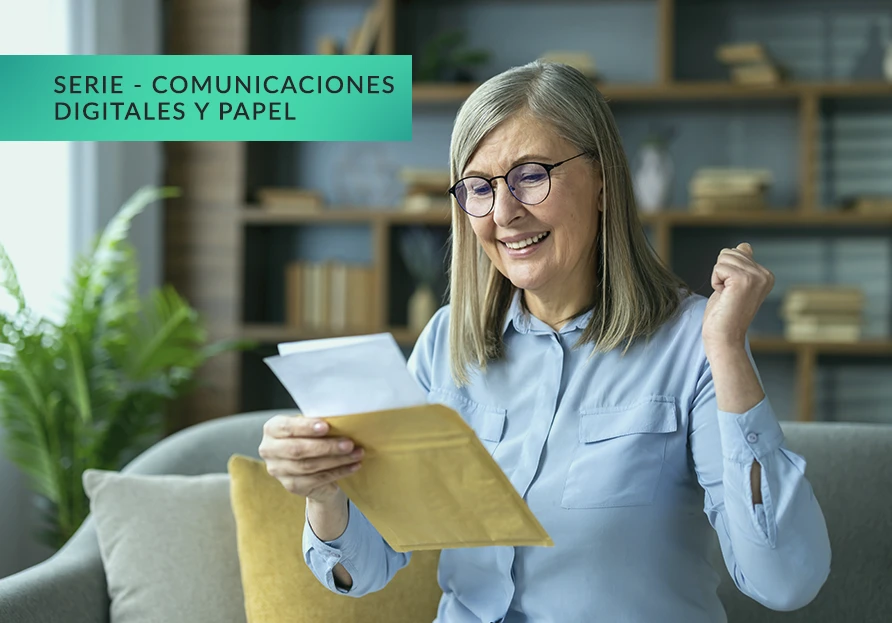Table of Contents
- Universal accessibility and bridging the digital divide
- Paper sustainability: A responsible approach
- Ergonomics of reading
- Durability of the support and unalterable physical backing
- Perception of importance and traditional trust
- Emotional impact and differentiation in a saturated environment
- Less distraction and greater concentration on the message
This post is the second in our monograph entitled “Digital and paper communications. Everything you need to know to compare and combine them” in which we analyze and compare both types of communications, with special emphasis on maximizing the advantages of each medium in a responsible way with people and the environment.
You can read the first entry on digital communications here.
Despite the digital boom, paper-based communication maintains its relevance and offers distinct advantages, especially in contexts such as banking and insurance:
Universal accessibility and bridging the digital divide
Paper-based communication is universally accessible, making it an indispensable channel for bridging the digital divide. Older clients, those less familiar with new technologies or with limited access to devices and internet connectivity, can access information easily and without barriers. In the banking and insurance sector, where the inclusion of all segments of the population is a social responsibility and a business imperative, paper ensures that no customer is excluded from receiving vital information, maintaining equity in access to services.
Paper sustainability: A responsible approach
Contrary to popular belief, paper use, when managed responsibly, is not a threat to future generations. If paper pulp is sourced from legal, certified and sustainable sources (such as responsibly managed forests with controlled planting and harvesting cycles), papermaking can be a circular process. In fact, the paper industry is the first stakeholder to ensure that deforestation does not exist and is not attributed to the manufacture of paper pulp. The main causes of deforestation globally are agricultural and livestock expansion, illegal mining, illegal logging and urbanization, not the production of paper from managed forests. Conscious use and proper recycling of paper further enhance its sustainability.
MailComms Group’s chain of custody is certified under the standards PEFC Certificate No.: AEN-PEFC-COC-0247 and FSC Certificate No.: AEN-COC-00075. This means that all the paper we use in certified projects with chain of custody for customers comes from responsibly managed forests, respecting traditional uses, guaranteeing reforestation and supporting local communities. FSC stands for Forest Stewardship Council and PEFC stands for Programme for the Endorsement of Forest Certification.

Ergonomics of reading
For a significant segment of the population, reading on paper is more comfortable and less tiring for the eyes than reading on digital screens. The absence of backlighting contributes to a more relaxed and concentrated reading experience.
Durability of the support and unalterable physical backing
Paper offers a durable, tangible medium that can be easily physically archived and consulted at any time, without the need for an electronic device, internet connection or concern for software or hardware failure. This feature provides a sense of security and unwavering backup for documentation such as mortgage contracts, deeds, life insurance policies or wills, where permanence and unalterability are fundamental requirements.
Perception of importance and traditional trust
A physical document, such as an official letter, a detailed bank statement or an insurance policy, is often perceived as more official and this perception of seriousness and formality is crucial for highly relevant legal, contractual or financial communications.
And while postal mail has some risks (loss, physical theft), it is not exposed to the complex cybersecurity threats of digital channels, so for many customers, the physical format engenders greater confidence in the security and confidentiality of information, particularly when dealing with sensitive data.

Emotional impact and differentiation in a saturated environment
In a saturated digital world, a well-designed paper communication can stand out and generate a more significant emotional and cognitive impact. A personalized letter, a high quality brochure or a printed annual report can be perceived as a more thoughtful, exclusive and valuable gesture by the entity, leading to improved brand perception and contributing to brand differentiation.
Less distraction and greater concentration on the message
Paper offers a more focused and interruption-free reading environment. This allows the customer to fully concentrate on the content of the message, which is vital for understanding complex documents such as the terms of a mortgage, the details of an insurance policy or the terms of an investment product.
Although we live in a digital era, paper-based communication continues to demonstrate its value as an effective, inclusive and responsible channel. Its ability to reach all audiences, its physical backing, the perception of security it conveys and its potential to generate emotional impact make it an indispensable tool in sectors where trust, clarity and durability are key.
At MailComms Group we believe in leveraging the strengths of each medium to build a more effective, human and sustainable communication.
In the next post, we will address how to achieve this strategic and balanced combination.

